Imagine standing in front of two nearly identical products. They look the same, function the same, and even solve the same problem. But one costs more, and yet, you choose it without hesitation. Why? What’s that invisible force pulling you toward one brand and not the other? It’s not just about the product, it’s about the story, the emotion, and the promise behind it. That split-second decision isn’t random; it’s the result of something deeper: brand positioning. It’s the magic that makes one brand feel like the obvious choice, while the other fades into the background.
The importance of brand positioning goes beyond a logo or a catchy tagline. It’s about carving out a distinct space in a crowded market, building trust, and creating an emotional connection with your target audience. Without it, exceptional products may fail to attract buyers.
A strong brand doesn’t just compete—it stands out, resonates, and stays top of mind. So, how can you ensure your brand becomes the obvious choice? In this blog, we’ll explore what brand positioning is, why it matters, and how you can craft a strategy that makes an unforgettable impact.
Table of Contents
What is Brand Positioning?
Brand positioning is the space your brand occupies in the minds of consumers. It’s how people perceive your brand compared to competitors and why they choose you over others.
It’s not just about logos, colors, or slogans; it’s about the unique value proposition that sets you apart. A well-positioned brand communicates who you are, what you offer, and why it matters. Whether you’re a premium brand known for luxury or a budget-friendly option offering reliability, your positioning influences customer decisions.
Effective brand positioning helps businesses stand out, build trust, and create emotional connections with their target audience. It ensures customers remember your brand when it’s time to make a purchase.
Without clear positioning, even the best products can get lost in the noise. But with a strong brand position, your business becomes the go-to choice in your industry. It’s not just marketing; it’s a long-term strategy for success.
Also Read: What is Positioning in Marketing: Types, Strategies and Benefits
What is a Brand Positioning Statement?
A brand positioning statement is a short sentence that explains how a brand wants people to see it. It tells who the customers are and what makes the product or service special.
A strong brand positioning helps people know the brand identity and why it is different. It keeps the message clear everywhere so customers can remember and trust the brand.
Examples of some famous positioning statements
1. Nestle
“Produce affordable, safe, and high-quality nutrition for everyone, regardless of their income level, taking advantage of our long-standing presence around the world.”
2. Disney
“For the young and young-at-heart, Walt Disney World is the theme park that best delivers an immersive and magical experience because Walt Disney World, and only Walt Disney World, connects you to the characters and worlds you most desire.”
3. Slack
“Slack is the collaboration hub that brings together the right people, information, and tools to get work done. From Fortune 100 companies to corner markets, millions worldwide use Slack to connect their teams, unify their systems, and drive their business forward.”
Why is Brand Positioning Important?
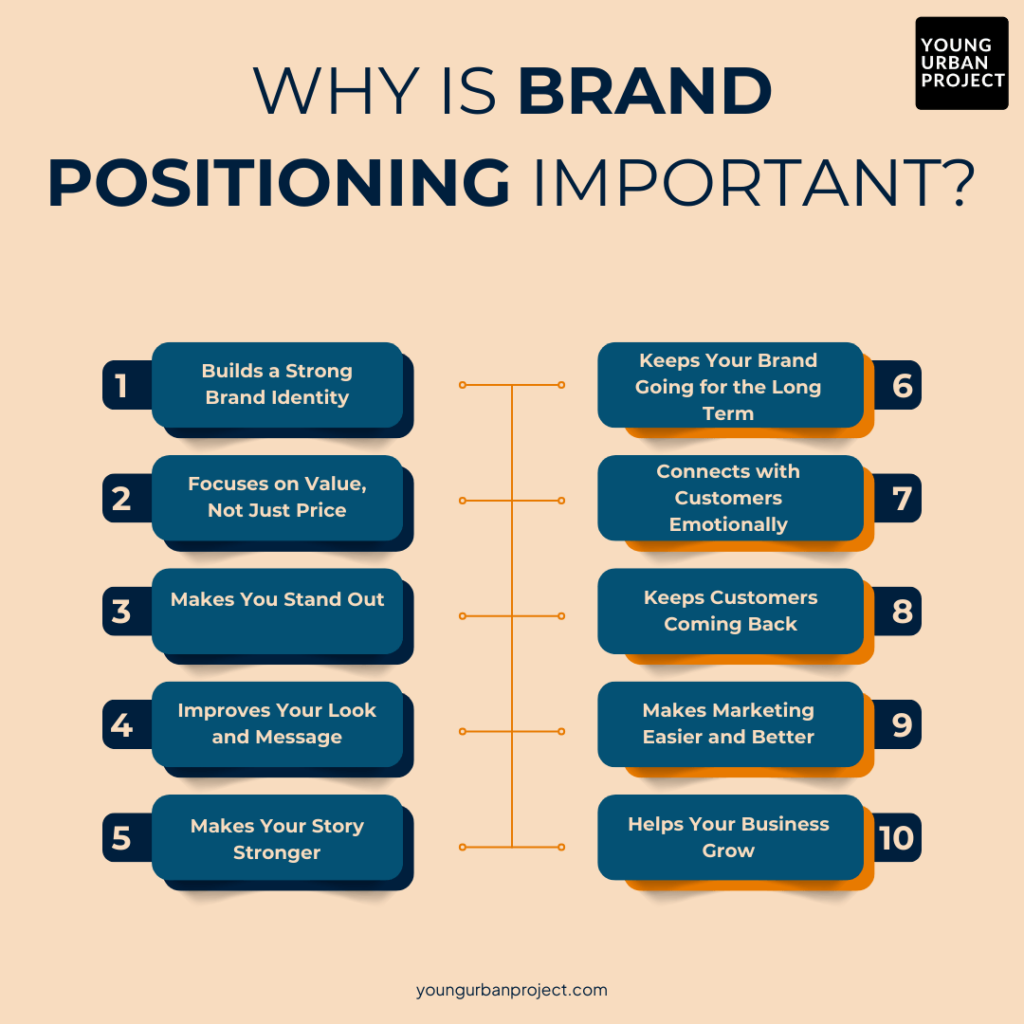
1. Builds a Strong Brand Identity
A well-defined brand position helps people immediately understand what your brand stands for. It ensures your messaging, design, and customer experience stay aligned, making your brand easily recognizable. Consistency builds trust—when customers see the same tone, colors, and values across different touchpoints, they feel more confident in choosing you. Without brand positioning, your business risks blending in with the competition and being easily forgotten.
2. Focuses on Value, Not Just Price
Competing solely on price is a race to the bottom. Strong brand positioning highlights your unique value, so customers choose you for what you offer, not just how cheap it is. People are willing to pay more for brands they trust, relate to, or admire. When your brand stands for something meaningful, customers see it as an investment rather than just another option. This approach boosts profitability and long-term growth.
Also Read: Penetration Pricing Strategy: A Comprehensive Guide
3. Makes You Stand Out
In a crowded marketplace, many brands offer similar products or services. Brand positioning helps carve out your own space by emphasizing what makes you different. Whether it’s your story, values, innovation, or customer experience, positioning creates a competitive edge. Instead of fighting for attention, you attract customers who resonate with your uniqueness, making it harder for competitors to copy or replace you.
4. Improves Your Look and Message
Your logo, colors, and tone of voice should all align with your brand positioning. A well-defined position helps guide these creative choices, ensuring they resonate with your target audience. If your brand is fun and youthful, your visuals and messaging should reflect that. If it’s premium and professional, your design and tone should match. This makes your brand instantly recognizable and reinforces the message you want to communicate.
5. Makes Your Story Stronger
People connect with stories, not just products. Brand positioning shapes the narrative behind your brand—who you are, why you exist, and how you make a difference. When your story is clear and emotionally compelling, it sticks in people’s minds. A strong story builds loyalty because customers don’t just see you as a business; they see you as part of their journey.
6. Keeps Your Brand Going for the Long Term
Brands that rely on discounts or hype tend to fade away. Strong positioning builds a foundation that keeps your brand relevant for years. When customers associate you with reliability, quality, or innovation, they stay loyal even when new competitors emerge. Instead of chasing short-term trends, you create lasting impact and trust, ensuring your business continues to grow.
7. Connects with Customers Emotionally
Buying decisions aren’t just logical—they’re emotional. A strong brand position speaks to what people feel, believe, and aspire to. When customers see your brand as a reflection of their values or identity, they form a deeper connection. This emotional bond makes them more likely to choose you over a competitor, even if alternatives exist.
8. Keeps Customers Coming Back
A well-positioned brand creates a sense of belonging. When customers feel understood and valued, they stick around. They’re not just buying a product; they’re becoming part of a community. This sense of connection builds trust and encourages repeat purchases, reducing churn and increasing word-of-mouth recommendations.
9. Makes Marketing Easier and Better
Without clear positioning, marketing feels scattered. You end up trying different messages and strategies, hoping something works. But when your brand position is strong, marketing becomes more focused and effective. Every campaign, social media post, or ad reinforces the same message, creating a more powerful and consistent brand presence. This not only improves results but also saves time and money.
10. Helps Your Business Grow
The strongest brands aren’t just known—they’re respected. A well-positioned brand attracts customers, partnerships, and new opportunities. Whether it’s being recognized as a leader in quality, trust, or innovation, strong positioning makes it easier to scale. Over time, this translates into higher sales, better customer retention, and a more influential place in the market.
How Do You Create a Brand Positioning Strategy?
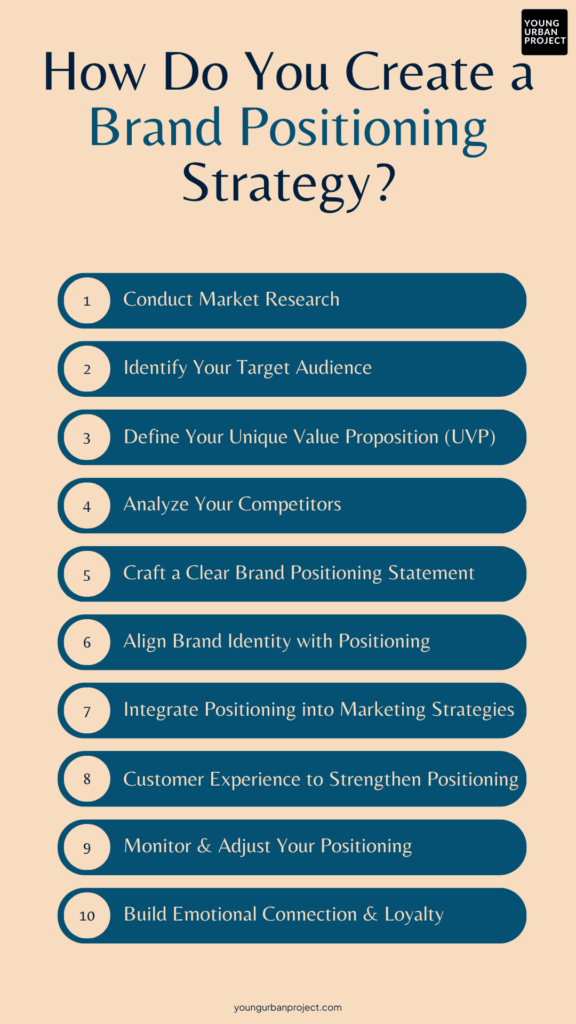
1. Conduct Market Research
Before deciding how to position your brand, you must understand your target market and competitors. Study industry trends, read customer reviews, and analyze competitor strategies. Find out what customers like, dislike, and expect. This research helps you differentiate your brand and fill market gaps. A well-researched strategy makes brand positioning effective and relevant.
2. Identify Your Target Audience
Knowing your target audience helps you create a message that connects with them. Define who they are—age, location, interests, and problems they face. When you understand your potential customers, you can build a brand identity that resonates with them. The clearer your audience, the stronger your brand positioning statement will be.
3. Define Your Unique Value Proposition (UVP)
Your unique value proposition is what makes your brand special. It answers, “Why should customers choose you over others?” It could be your quality, price, customer service, or innovation. A strong value proposition gives your brand a competitive edge. Make sure your UVP is clear in all marketing efforts and messaging.
4. Analyze Your Competitors
To stand out, you must know what others are doing. Study your competitors’ brand positioning strategies. Spot their strong points and their weak areas. Find gaps where your brand can offer something better. This will help you differentiate and create a strong brand that attracts customers.
5. Craft a Clear Brand Positioning Statement
A brand positioning statement explains what your brand does, who it serves, and why it matters. It should be short, clear, and impactful. This statement acts as a guide for all your marketing strategies. A well-crafted positioning statement makes your brand’s message consistent across all platforms.
6. Align Brand Identity with Positioning
Your brand identity includes your logo, colors, fonts, and tone of voice. These elements should match your brand position. If your brand stands for luxury, your branding should feel premium. If you focus on affordability, your design should reflect that. A powerful brand identity helps people remember you.
7. Integrate Positioning into Marketing Strategies
Your brand positioning should be part of everything you do—social media, advertising, website content, and customer interactions. Every message should communicate your brand promise. When all your marketing efforts align with your positioning, your brand becomes more credible and recognizable.
8. Use Customer Experience to Strengthen Positioning
Your brand positioning is only effective if your customers experience what you promise. If you claim to offer premium quality, your service must match it. Good customer support, easy shopping experiences, and high-quality products build trust. Happy customers become loyal supporters of your brand stand.
9. Monitor & Adjust Your Positioning
Market trends change, and so do customer preferences. Keep track of how your brand positioning strategy is performing. Use customer feedback, surveys, and analytics to see if your message still connects with your audience. If needed, adjust your strategy to stay relevant. Effective brand positioning requires flexibility.
10. Build Emotional Connection & Loyalty
A strong brand connects with people emotionally. Customers are loyal to brands that stand for the same things they do. Use storytelling, transparency, and community-building to deepen relationships. When customers feel connected, they trust your brand and recommend it to others. Emotional bonds create long-term success and increase market share.
Examples of Brand Positioning: Who Did It Best?
1. Zara vs. H&M: Fast Fashion Rivals
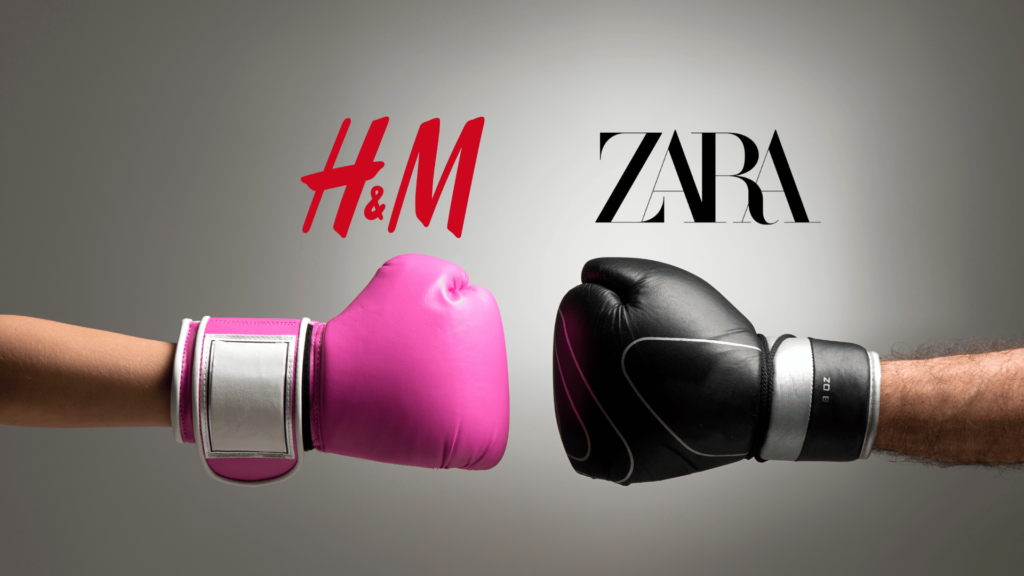
Why Zara Wins:
✅ Speed-to-Market Advantage: Zara takes just 2 weeks to launch a new trend, while H&M follows a more traditional fashion cycle.
✅ Higher Perceived Quality: Positioned as slightly more premium, Zara attracts trend-conscious consumers willing to pay more.
✅ Scarcity Strategy: Limited stock creates urgency and desirability, making shoppers buy quickly.
Why H&M Wins:
✅ Mass Market Pricing: H&M positions itself as the more affordable option, appealing to budget-conscious fashion lovers.
✅ Sustainability Positioning: H&M has heavily invested in eco-friendly initiatives, unlike Zara, which has faced sustainability concerns.
✅ Global Expansion & Accessibility: H&M has a wider global footprint, making it easier to access for customers.
Final Verdict: Zara leads in trend-driven, aspirational fashion, while H&M wins in affordable, sustainable clothing.
2. Airbnb vs. Marriott: Experience vs. Luxury
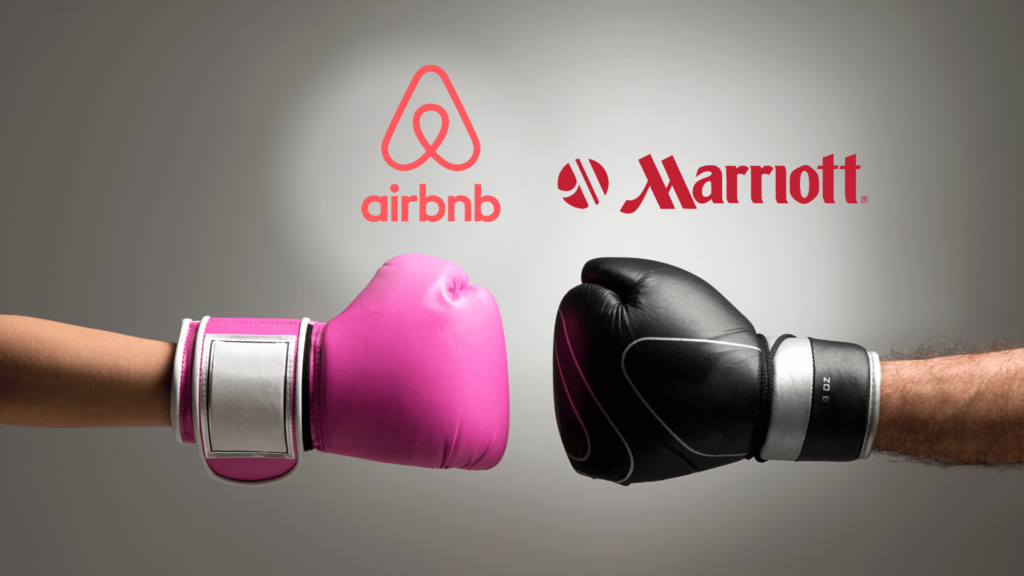
Why Airbnb Wins:
✅ Community & Experience First: Airbnb positions itself as a lifestyle and travel experience brand, not just an accommodation provider.
✅ Affordable & Localized: Unlike Marriott’s standardized luxury, Airbnb offers unique, local stays at every price point.
✅ User-Generated Growth: Hosts act as brand ambassadors, helping Airbnb scale without owning real estate.
Why Marriott Wins:
✅ Unmatched Luxury & Prestige: Marriott owns a strong premium and business travel positioning that Airbnb can’t replicate.
✅ Reliability & Comfort: Standardized experiences make Marriott the go-to choice for corporate travelers and elite tourists.
✅ Loyalty Programs & Trust: A Marriott Bonvoy membership creates repeat customers, while Airbnb lacks a strong loyalty ecosystem.
Final Verdict: Airbnb wins for adventure seekers and budget travelers, while Marriott remains the top choice for those who want consistency and luxury.
3. Spotify vs. Apple Music: The Streaming War

Why Spotify Wins:
✅ Personalized Experience: Spotify’s AI-driven recommendations and playlists create a deeply personal music journey.
✅ Freemium Model for Wider Reach: Unlike Apple Music, Spotify lets users enjoy free streaming with ads, making it more accessible.
✅ Strong Social & Community Features: – Playlist sharing, collaborative playlists, and Spotify Wrapped create viral engagement.
Why Apple Music Wins:
✅ Superior Sound Quality: Apple Music offers lossless audio, appealing to audiophiles who value sound over convenience.
✅ Seamless Apple Ecosystem: Apple Music integrates perfectly with iPhones, iPads, and HomePods, making it the default choice for Apple users.
✅ Exclusive Artist Deals: Apple Music secures exclusive album releases, giving it a competitive edge over Spotify.
Final Verdict: Spotify dominates the global streaming market, but Apple Music retains premium users who value exclusivity and sound quality.
4. Fenty Beauty vs. MAC: Inclusivity vs. Legacy

Why Fenty Beauty Wins:
✅ Revolutionized Shade Inclusivity: Fenty introduced 40+ foundation shades, setting a new standard for diversity.
✅ Celebrity Branding Done Right: Rihanna’s involvement feels authentic, making Fenty relatable and aspirational.
✅ Direct-to-Consumer First Approach: Fenty used social media and influencer marketing to drive sales without relying on retail stores.
Why MAC Wins:
✅ Professional-Grade Makeup: MAC is known for high-performance, long-lasting makeup, favored by makeup artists worldwide.
✅ Brick-and-Mortar Trust: MAC’s physical store presence ensures a try-before-you-buy experience that Fenty lacks.
✅ Loyal Customer Base: MAC has decades of brand trust, making it a default choice for many consumers.
Final Verdict: Fenty disrupted the beauty industry with inclusivity, while MAC remains the go-to for professional makeup artists.
5. Tata Tea vs. Brooke Bond—India’s Chai Champions
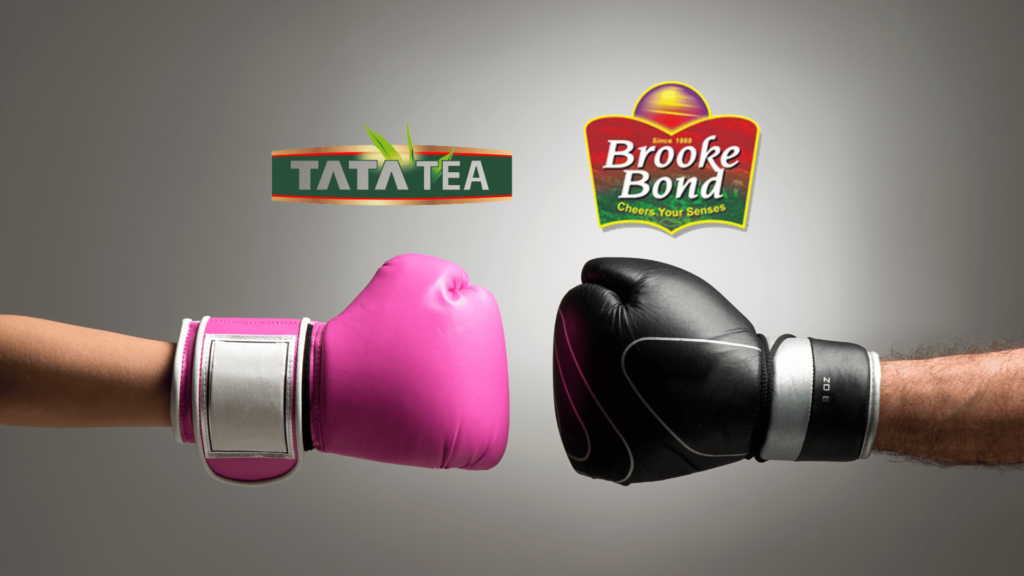
Why Tata Tea Wins:
✅ Strong Nationalistic Positioning: Tata Tea’s “Jaago Re” campaign positioned it as a brand with a purpose, resonating with socially conscious consumers.
✅ Premium & Specialty Tea Market Leader: With Tata Tea Gold, Tata Tea Premium, and Tetley, it has a strong presence in the premium and health-conscious tea segments.
✅ Diversification into Green & Herbal Teas: Unlike Brooke Bond, Tata Tea aggressively expanded into organic and wellness teas, appealing to health-conscious consumers.
Why Brooke Bond Wins:
✅ Household Trust & Affordability: Brooke Bond’s Red Label and Taj Mahal Tea dominate the affordable and everyday tea market in India.
✅ Widespread Availability: Brooke Bond has one of the largest distribution networks, ensuring it reaches even the smallest villages.
✅ Emotional Advertising & Cultural Relevance: Campaigns like “Taste of Togetherness” (Red Label) have helped Brooke Bond build deep emotional connections with consumers.
Final Verdict: Tata Tea wins premium & socially driven consumers, while Brooke Bond owns the mass-market, everyday tea segment.
Conclusion
In a world where consumers are bombarded with choices, brand positioning is what sets a brand apart. It’s not just about selling a product or service—it’s about crafting a unique value proposition that resonates with your target audience. Strong brand positioning helps businesses differentiate, build trust, and create lasting emotional connections.
Brands that position themselves effectively don’t compete on price alone—they compete on value, relevance, and credibility. Whether it’s Tata Tea’s social messaging, Haldiram’s premium snacking appeal, or Rapido’s niche-focused strategy, the right positioning influences market share, brand awareness, and customer loyalty.
Ultimately, a brand’s success depends on how well it communicates its brand promise and aligns with the needs of potential customers. Investing in a clear, consistent, and credible positioning strategy ensures long-term sustainability and competitive advantage in a crowded market. Position your brand wisely—because perception is everything!
1. What Does Brand Positioning Mean?
Brand positioning is how people see a brand compared to others. It shows why a product or service is special. A good brand strategy makes customers choose your brand over others. It also helps businesses stay clear on their message and stand out in the market.
2. Why Does Brand Positioning Matter?
Brand positioning helps a brand get noticed. It makes sure customers know what it offers and why it is better. A strong brand builds trust and keeps customers loyal. Without good positioning, a brand may lose sales and struggle to compete.
3. What Are the Benefits of Good Brand Positioning?
A strong brand attracts more customers and keeps them coming back. It makes sure people remember it and prefer it over others. A well-positioned brand does not have to lower prices to compete. It also makes marketing easier because the message is clear.
4. How Can a Brand Improve Its Positioning?
A brand can improve its positioning by knowing what customers want. It must offer something special that others don’t. Good marketing, a clear brand identity, and keeping promises help a brand stand out. Strong brand positioning builds trust and loyalty.
5. What Happens If a Brand Has No Clear Positioning?
If a brand is not well-positioned, people may not notice it. Customers may not understand what makes it different. This makes it harder to gain trust and loyalty. Weak brand positioning can also lead to lower sales and more competition on price.
6. Can a Brand Change Its Positioning?
Yes, a brand can change its positioning strategy if needed. It should do this carefully to stay true to its values. Many brands adjust to new trends, like focusing on eco-friendly products or digital services. A strong brand strategy helps make repositioning smooth and successful.

